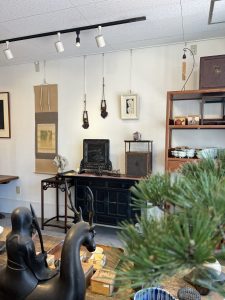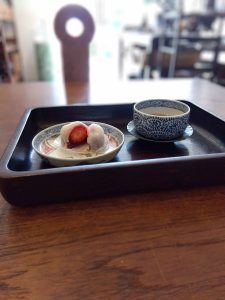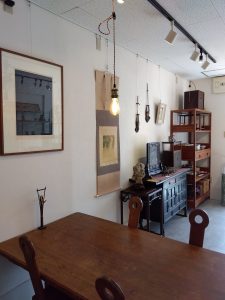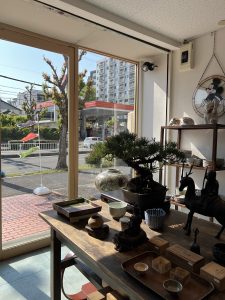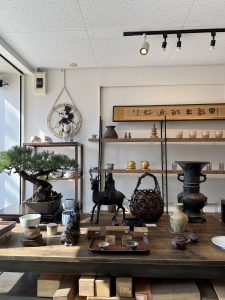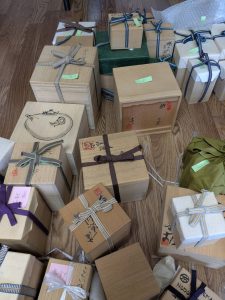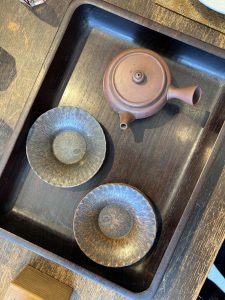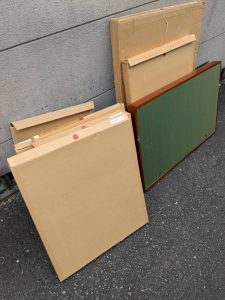たかがエスカレーターではありますが(愛知県名古屋市千種区姫池通 骨董買取 古美術風光舎)
2025.04.30
昨日のスタッフブログにもありましたが、私も子供が手を離れてからは、ゴールデンウィークに遠出するという意識が薄れております。今年は飛び石連休だとのこと。先日友人から連休前半は温泉に行くという話を聞き、前半っていつだっけ?とピンと来ていない自分に驚きました。
子供の手は離れましたが、親の手を取る年齢となり右往左往する日々ですが、移動中はちょっとした小旅行気分を味わっています。たった数時間の距離ですが空気が変わる気がするのです。
空気だけでなく、様々な慣習の違いも面白く、到着駅のエスカレーターに乗る時には脳が一瞬混乱します。日本のほとんどの地域では左側に立ち、主に関西地域では右側に立つという慣習の違いがあるようです。とはいえ昨今は効率的な人の流れを作るため、または片側を歩くことによる転倒の危険やエスカレーターの故障などを防ぐために両側に立つことが推奨されています。個人的な意見ですが名古屋ではこの両側立ちがかなり浸透してきているように思うのですが、大阪などではまだ左側だけに立つ人が多い気がしています。
これも個人的意見ですが、名古屋で両側立ちが浸透してきた一因として、時々出くわす「ストップしてね」と書かれた「巨大な手」作戦が功を奏しているのではと思っています。黄色い大きな手のひらを背負った若いスタッフ?がエスカレーターの右側を上り下りして強制的に右側をせき止めるのです。自分が流れをせき止めるのは、最初は中々勇気がいりますが、この手のひらのお陰で誰も罪悪感を抱かず、右側に堂々と立つことができ、何度か経験するうちに右側に立つことに抵抗感がなくなっていくのではないかと。他の地域でも何か工夫がされているのでしょうか?
そもそもなぜ関西地方だけ右側なのか。全国的に左側に立つのが多いのは、車が左側通行だからという説や、時代を遡れば武士が刀を左腰に差していて、刀がぶつからないよう昔から左側通行だったからなど、色々とささやかれております。
ますます関西の右側立ちが不思議に思えてきましたので調べてみると、有力な説として1967年に阪急梅田駅にエスカレーターが設置された際に流れたアナウンスが「お歩きになる方のために左側をお空けください」だったからというのがあります。
また1970年の大阪万博が開催された頃に海外から人が押し寄せ、欧州では主流である右立ちが根付いたともいわれています。
今回エスカレーターについて調べていますと、意外なことに各地のエスカレーターにひたすら乗り続ける動画や、変わり種のエスカレーターの紹介など、エスカレーターマニアの方々の動画やSNSを多数発見しました。しかもかなりの再生回数で驚きました。
面白いところでは、世界一短いとギネス認定されているエスカレーターが神奈川県川崎市の商業施設にあるとのこと。長さは5段で83.4cm、所要時間は8秒だそうです。もともと長いエスカレーターを作るはずでしたが、工事途中に発見された太い梁により長くすることが出来ず現在の状態になったそうです。今では「プチカレーター」の愛称で観光地のひとつになっているとか。
名古屋にも世界に3台しかないエスカレーターのうちの2台が並んでいる場所があるそうです。名古屋駅近くの名鉄百貨店の8階と9階を繫ぐ2台で、手すりの先がぐるっと回り込む箇所が、垂直に地面に潜っていくのだとか。文章で表現するのは中々難しいので、興味のある方は写真などチェックしてみてください。世界で3台と聞くとぜひ実物を拝見しなければ。すっかりにわかエスカレーターマニアとなっています。
私のお勧めのエスカレーターは大阪の梅田スカイビルにある空中庭園展望台へとつづく空中エスカレーターです。二つのビルをつなぐチューブの中を進むエレベーターで、高所恐怖症の方でなければ両側の絶景が楽しめます。
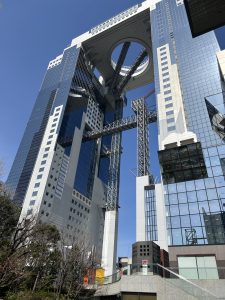
そして今までで一番驚いたエスカレーターは、大昔に訪れたロシアの地下鉄のエスカレーターでした。とにかく尋常ではない深さで乗った瞬間、降り口が全く見えず、遥か彼方の点に吸い込まれていく感じで、地中深く潜っていくうちに恐怖すら感じました。そしてスピードが速いのです。乗り口でステップがビュンビュン流れるのでいつ足を踏み出せばいいか分からず、意を決して乗ると体が前に引っ張られバランスを崩すほどでした。しかし慣れというのは凄いもので、帰国した時に関空のエスカレーターがスローすぎて「故障してる?」と感じた自分がいました。慣れというのは有難くもあり、恐ろしくもあります。
それでは、また次の機会に(スタッフH)
As mentioned in yesterday’s staff blog, I have been less inclined to go away for Golden Week since my children have been out of the picture. This year, I heard that the holidays are a series of stepping stones. The other day I heard from a friend that the first half of the holidays will be spent at a hot spring, and I was surprised to find myself wondering when the first half was. I was surprised to find myself unable to remember when the first half of the year was.
My children are now old enough to take their parents’ hands, but I still feel like I’m on a short trip when I’m on the road. It is only a few hours away, but I feel as if the air changes.
Not only the air, but also the differences in customs are interesting, and when I ride the escalator at the arrival station, my brain gets confused for a moment. There seems to be a difference in customs: in most parts of Japan, people stand on the left side, and mainly in the Kansai region, people stand on the right side. Nowadays, however, it is recommended to stand on both sides for efficient flow of people or to prevent the danger of falling or malfunctioning escalators due to walking on one side. My personal opinion is that this practice of standing on both sides of the escalator is becoming more common in Nagoya, but in Osaka and other cities, many people still stand only on the left side.
This is my personal opinion, but I think that one of the reasons why people stand on both sides of the street in Nagoya is because of the “giant hand” strategy with a sign saying “Stop, please” that I sometimes come across. A young staff member carrying a large yellow hand? s go up and down the right side of the escalator and forcibly hold up the right side of the escalator. It takes a lot of courage at first to stand on the right side of the escalator, but thanks to this palm, no one feels guilty and can stand proudly on the right side. Are there any other innovations in other regions as well?
Why is it only the Kansai region on the right side in the first place? Some say that it is because cars drive on the left side of the road. Others say that it is because samurai used to carry their swords on the left side of the road so that their swords would not collide with each other.
I began to wonder why people in Kansai stand on the right side of the road, so I looked it up. One popular theory is that when an escalator was installed at Hankyu Umeda Station in 1967, the announcement that went out was “Please leave the left side of the road for those walking.
It is also said that when the 1970 Osaka World’s Fair was held, people from abroad flocked to the area, and the right side standing, which is the mainstream in Europe, took root.
While researching elevators this time, I unexpectedly found many videos and social networking sites of escalator enthusiasts, such as videos of people continuously riding escalators in various places and introductions to different types of escalators. Moreover, I was surprised at the considerable number of views.
One interesting point is that the escalator certified by Guinness as the world’s shortest is located at a commercial facility in Kawasaki City, Kanagawa Prefecture. The length of the escalator is 83.4 cm with 5 steps and the time required is 8 seconds. The escalator was originally supposed to be a long escalator, but a thick beam discovered during construction made it impossible to lengthen the escalator and it ended up in its current state. It is now one of the tourist attractions with the nickname of “Petit Carreter.
There is a place in Nagoya where two of the only three escalators in the world stand side by side. The two escalators connect the 8th and 9th floors of the Meitetsu Department Store near Nagoya Station, and the end of the handrail wraps around the escalator and dives vertically into the ground. It is difficult to describe in words, so if you are interested, please check out the photos. When I heard that there are only three of these escalators in the world, I had to see the real thing. I’ve become a bit of an escalator fanatic.
I recommend the escalator that leads to the Hanging Garden Observation Deck in the Umeda Sky Building in Osaka. There is a fee for the Hanging Garden, but the escalator is free. The escalator goes through a tube connecting the two buildings, and if you are not afraid of heights, you can enjoy the spectacular view on both sides.
And the most amazing escalator I have ever experienced was an escalator in a Russian subway I visited a long time ago. The escalator was so deep that I could not see the exit at all and felt fear as it went deep underground. And the speed was very fast. The steps were whizzing by so fast that I didn’t know when to step out, and when I finally got on, my body was pulled forward, causing me to lose my balance. But when I returned to Japan, I found that the escalators at Kansai International Airport were so slow that I felt, “Is it malfunctioning? I felt that the escalator at Kansai International Airport was so slow that I was wondering if it was broken. Familiarity is both a blessing and a curse.
See you next time (Staff H)
If you have time, please come visit us at Fukousha Antique Gallery.
*****************
ご実家の整理やお片付けなどをされている方のご相談などが多くございます。
お片付けなどくれぐれもご無理のないようになさってくださいませ。
風光舎では古美術品や骨董品の他にも絵画や宝石、趣味のお品など様々なジャンルのものを買受しております。
お片付けをされていて、こういうものでもいいのかしらと迷われているものでも、どうぞお気軽にご相談下さいませ。
また風光舎は、出張買取も強化しております。ご近所はもちろん、愛知県内、岐阜県、三重県その他の県へも出張いたします。
まずは、お電話お待ちしております。
なお、毎月21日の持込鑑定会では無料鑑定・買取・持込など、ご予約なしで承っております。
ご近所の皆さま、ご遠方のみなさまも、お気軽にお越しくださいませ。
愛知県名古屋市千種区姫池通
骨董 買取【古美術 風光舎 名古屋店】
TEL052(734)8444
10:00-18:00 OPEN
#出張買取#骨董#古美術#骨董品#絵画#版画#茶道具#刀剣#彫刻

